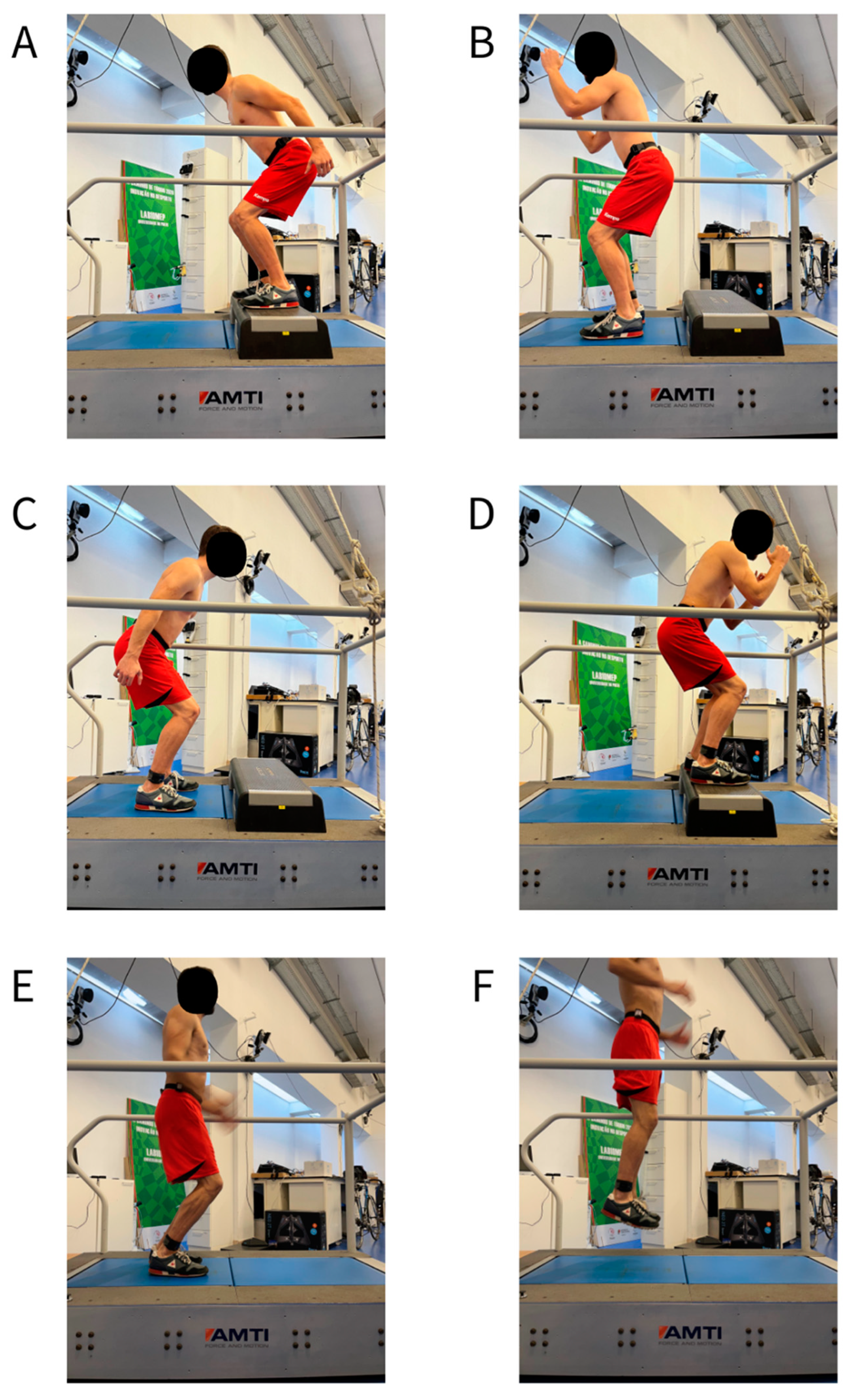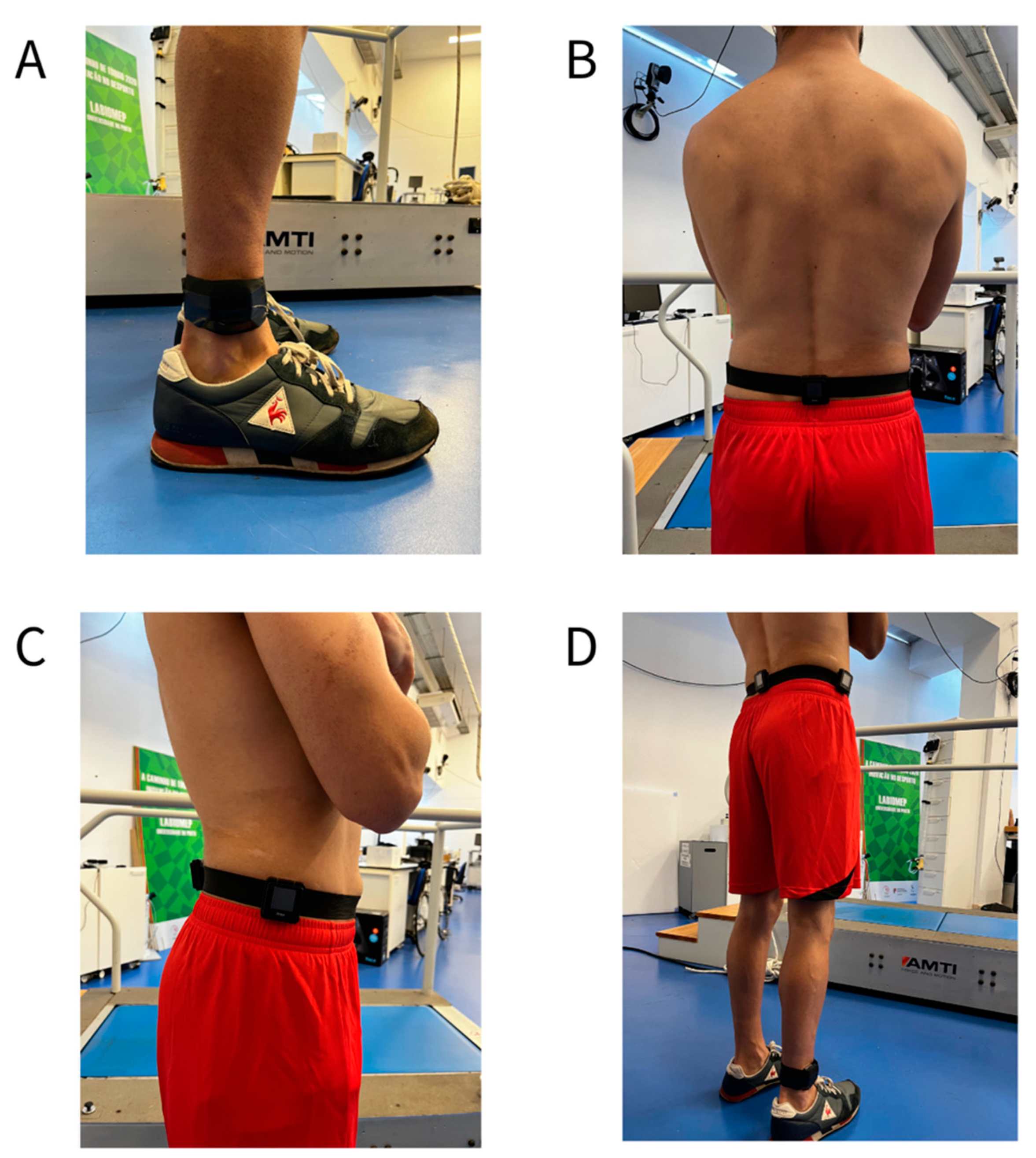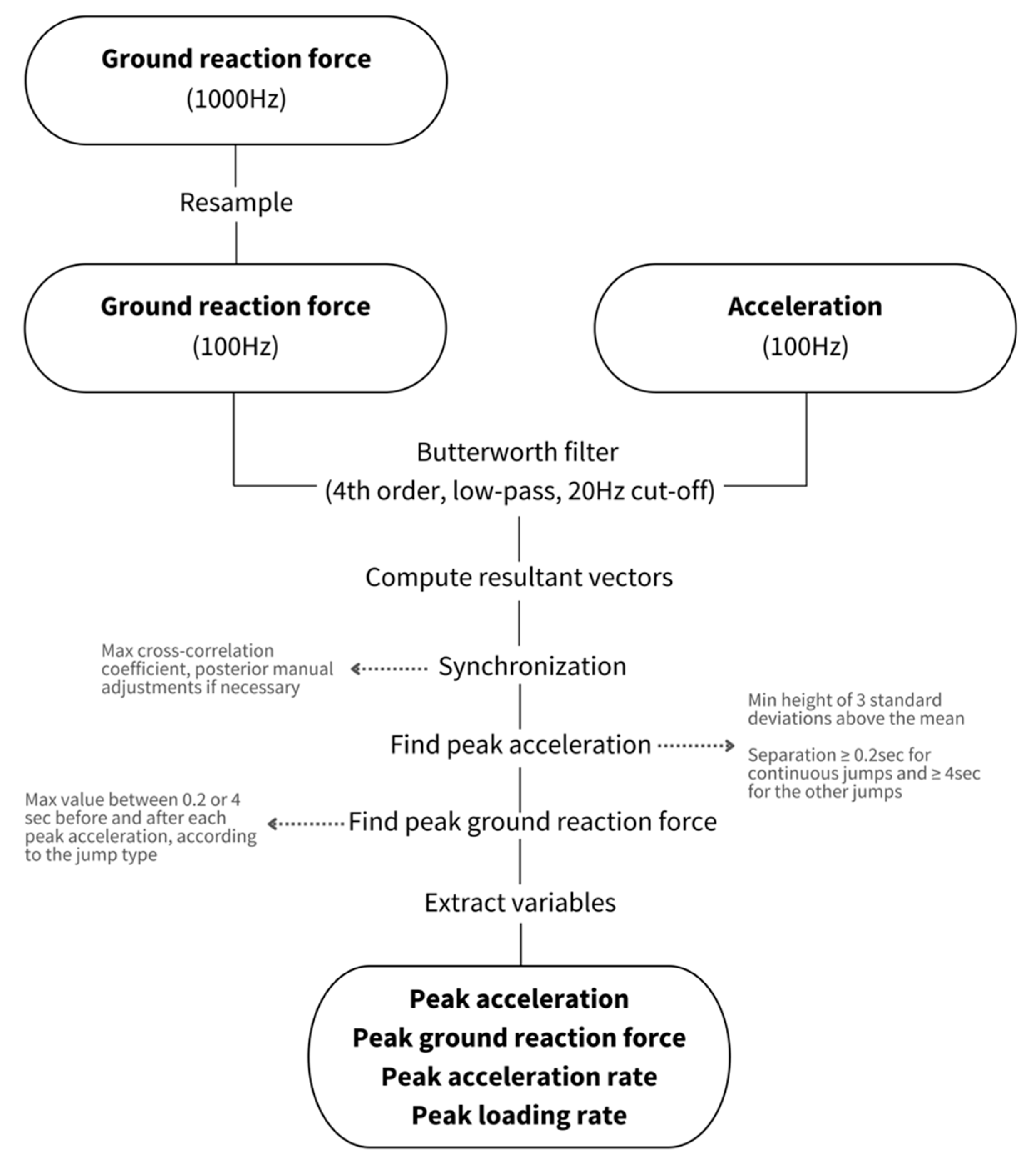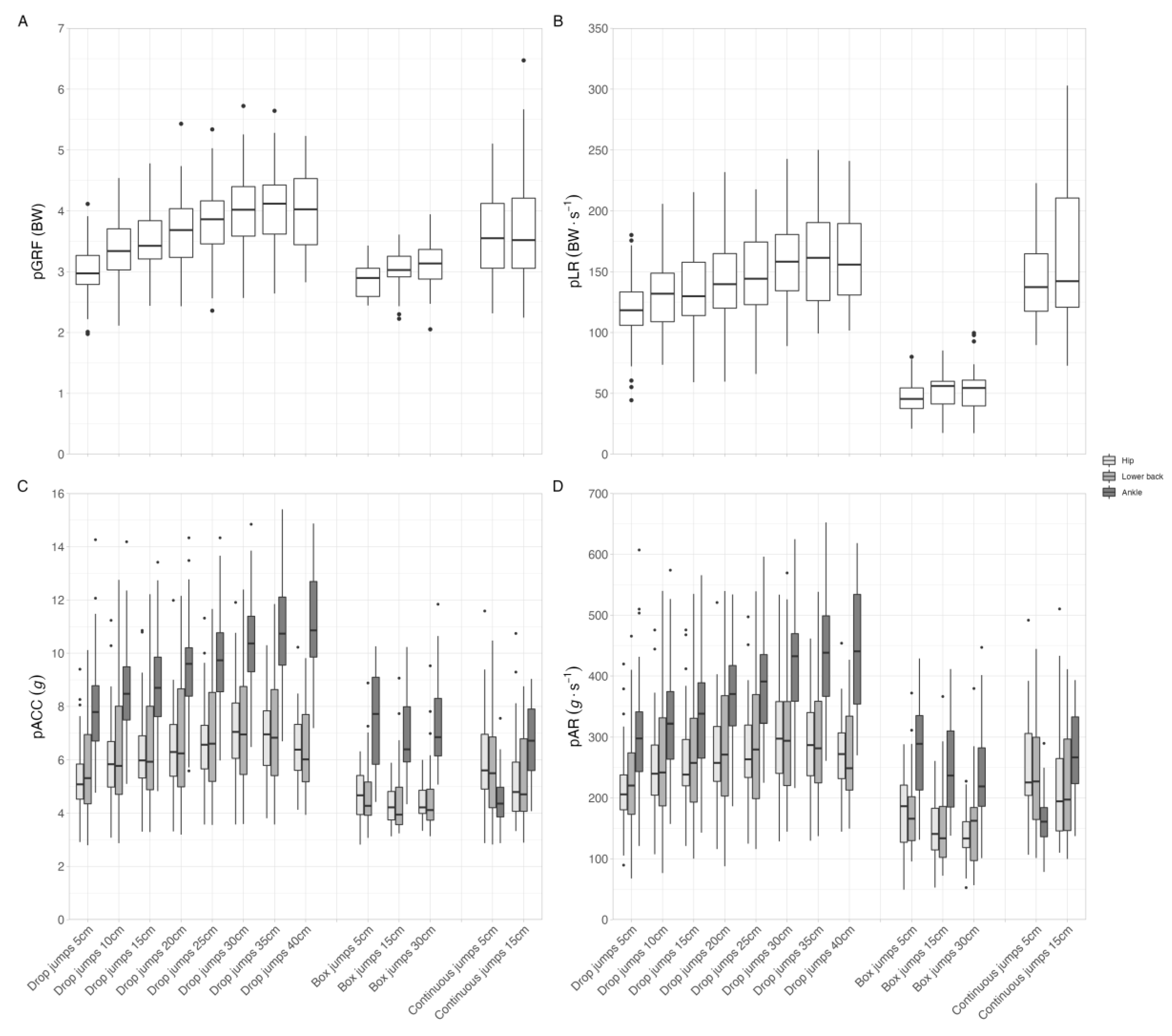Using Raw Accelerometer Data to Predict High-Impact Mechanical Loading
Abstract
1. Introduction
2. Methods
2.1. Participants
2.2. Protocol
2.3. Data Processing
2.4. Statistical Analyses
3. Results
4. Discussion
Supplementary Materials
Author Contributions
Funding
Institutional Review Board Statement
Informed Consent Statement
Data Availability Statement
Acknowledgments
Conflicts of Interest
References
- Turner, C.H.; Robling, A.G. Designing exercise regimens to increase bone strength. Exerc. Sport Sci. Rev. 2003, 31, 45–50. [Google Scholar] [CrossRef]
- Fonseca, H.; Moreira-Goncalves, D.; Coriolano, H.J.; Duarte, J.A. Bone quality: The determinants of bone strength and fragility. Sport. Med. 2014, 44, 37–53. [Google Scholar] [CrossRef]
- Santos, L.; Elliott-Sale, K.J.; Sale, C. Exercise and bone health across the lifespan. Biogerontology 2017, 18, 931–946. [Google Scholar] [CrossRef] [PubMed]
- Kohrt, W.M.; Bloomfield, S.A.; Little, K.D.; Nelson, M.E.; Yingling, V.R. Physical activity and bone health. Med. Sci. Sport. Exerc. 2004, 36, 1985–1996. [Google Scholar] [CrossRef] [PubMed]
- Burr, D.B.; Robling, A.G.; Turner, C.H. Effects of biomechanical stress on bones in animals. Bone 2002, 30, 781–786. [Google Scholar] [CrossRef]
- Turner, C.H. Three rules for bone adaptation to mechanical stimuli. Bone 1998, 23, 399–407. [Google Scholar] [CrossRef]
- Turner, C.H.; Robling, A.G. Mechanisms by which exercise improves bone strength. J. Bone Miner. Metab. 2005, 23, 16–22. [Google Scholar] [CrossRef]
- Nikander, R.; Kannus, P.; Rantalainen, T.; Uusi-Rasi, K.; Heinonen, A.; Sievänen, H. Cross-sectional geometry of weight-bearing tibia in female athletes subjected to different exercise loadings. Osteoporos. Int. 2010, 21, 1687–1694. [Google Scholar] [CrossRef] [PubMed]
- Groothausen, J.; Siemer, H.; Kemper, H.C.G.; Twisk, J.; Welten, D.C. Influence of peak strain on lumbar bone mineral density: An analysis of 15-year physical activity in young males and females. Pediatr. Exerc. Sci. 1997, 9, 159–173. [Google Scholar] [CrossRef]
- Weeks, B.K.; Beck, B.R. The BPAQ: A bone-specific physical activity assessment instrument. Osteoporos. Int. 2008, 19, 1567–1577. [Google Scholar] [CrossRef] [PubMed]
- Farr, J.N.; Lee, V.R.; Blew, R.M.; Lohman, T.G.; Going, S.B. Quantifying bone-relevant activity and its relation to bone strength in girls. Med. Sci. Sport. Exerc. 2011, 43, 476–483. [Google Scholar] [CrossRef]
- Kim, S.J.; So, W.Y.; Kim, J.; Sung, D.J. Relationship between bone-specific physical activity scores and measures for body composition and bone mineral density in healthy young college women. PLoS ONE 2016, 11, e0162127. [Google Scholar] [CrossRef]
- Kim, S.J.; Baker, B.S.; Sharma-Ghimire, P.; Bemben, D.A.; Bemben, M.G. Association between bone-specific physical activity scores and pQCT-derived measures of bone strength and geometry in healthy young and middle-aged premenopausal women. Arch. Osteoporos. 2018, 13, 83. [Google Scholar] [CrossRef]
- Medved, V. Measurement of Human Locomotion; CRC Press: London, UK, 2000. [Google Scholar]
- Elvin, N.G.; Elvin, A.A.; Arnoczky, S.P. Correlation between ground reaction force and tibial acceleration in vertical jumping. J. Appl. Biomech. 2007, 30, 75–81. [Google Scholar] [CrossRef] [PubMed]
- Rowlands, A.V.; Stiles, V.H. Acceleration counts and raw acceleration output in relation to mechanical loading. J. Biomech. 2012, 45, 448–454. [Google Scholar] [CrossRef] [PubMed]
- Neugebauer, J.M.; Hawkins, D.A.; Beckett, L. Estimating youth locomotion ground reaction forces using an accelerometer-based activity monitor. PLoS ONE 2012, 7, e48182. [Google Scholar] [CrossRef] [PubMed]
- Neugebauer, J.M.; Collins, K.H.; Hawkins, D.A. Ground reaction force estimates from ActiGraph GT3X+ hip accelerations. PLoS ONE 2014, 9, e99023. [Google Scholar] [CrossRef] [PubMed]
- Fortune, E.; Morrow, M.M.B.; Kaufman, K.R. Assessment of gait kinetics using tri-axial accelerometers. J. Appl. Biomech. 2014, 30, 668–674. [Google Scholar] [CrossRef] [PubMed]
- Neugebauer, J.M.; LaFiandra, M. Predicting ground reaction force from a hip-borne accelerometer during load carriage. Med. Sci. Sport. Exerc. 2018, 50, 2369–2374. [Google Scholar] [CrossRef]
- Veras, L.; Diniz-Sousa, F.; Boppre, G.; Devezas, V.; Santos-Sousa, H.; Preto, J.; Vilas-Boas, J.P.; Machado, L.; Oliveira, J.; Fonseca, H. Accelerometer-based prediction of skeletal mechanical loading during walking in normal weight to severely obese subjects. Osteoporos. Int. 2020, 31, 1239–1250. [Google Scholar] [CrossRef]
- Veras, L.; Diniz-Sousa, F.; Boppre, G.; Resende-Coelho, A.; Moutinho-Ribeiro, E.; Devezas, V.; Santos-Sousa, H.; Preto, J.; Vilas-Boas, J.P.; Machado, L.; et al. Mechanical loading prediction through accelerometry data during walking and running. Eur. J. Sport Sci. 2022. online ahead of print. [Google Scholar] [CrossRef] [PubMed]
- Komaris, D.; Pérez-Valero, E.; Jordan, L.; Barton, J.; Hennessy, L.; O´Flynn, B.; Machado, G. Predicting three-dimensional ground reaction forces in running by using artificial neural networks and lower body kinematics. IEEE Access 2019, 7, 156779–156786. [Google Scholar] [CrossRef]
- Sharma, D.; Davidson, P.; Müller, P.; Piché, R. Indirect estimation of vertical ground reaction force from a body-mounted INS/GPS using machine learning. Sensors 2021, 21, 1553. [Google Scholar] [CrossRef] [PubMed]
- Alcantara, R.S.; Edwards, W.B.; Millet, G.Y.; Grabowski, A.M. Predicting continuous ground reaction forces from accelerometers during uphill and downhill running: A recurrent neural network solution. PeerJ 2022, 10, e12752. [Google Scholar] [CrossRef] [PubMed]
- Du, J.; Hartley, C.; Brooke-Wavell, K.; Paggiosi, M.A.; Walsh, J.S.; Li, S.; Lin, S. High-impact exercise stimulated localized adaptation of microarchitecture across distal tibia in postmenopausal women. Osteoporos. Int. 2021, 32, 907–919. [Google Scholar] [CrossRef] [PubMed]
- Allison, S.; Poole, K.E.; Treece, G.M.; Gee, A.H.; Tonkin, C.; Rennie, W.J.; Folland, J.P.; Summers, G.D.; Brooke-Wavell, K. The influence of high-impact exercise on cortical and trabecular bone mineral content and 3D distribution across the proximal femur in older men: A randomized controlled unilateral intervention. J. Bone Miner. Res. 2015, 30, 1709–1716. [Google Scholar] [CrossRef]
- Hansford, H.J.; Wewege, M.A.; Cashin, A.G.; Hagstrom, A.D.; Clifford, B.K.; McAuley, J.H.; Ortega, F. If exercise is medicine, why don’t we know the dose? An overview of systematic reviews assessing reporting quality of exercise interventions in health and disease. Br. J. Sport. Med. 2022, 56, 692–700. [Google Scholar] [CrossRef]
- White, M.G.E.; Bezodis, N.E.; Neville, J.; Summers, H.; Rees, P. Determining jumping performance from a single body-worn accelerometer using machine learning. PLoS ONE 2022, 17, e0263846. [Google Scholar] [CrossRef]
- National Health and Nutrition Examination Survey. National Health and Nutrition Examination Survey (NHANES) Anthropometry Procedures Manual. Center for Disease Control and Prevention. 2017. Available online: https://wwwn.cdc.gov/nchs/data/nhanes/2017-2018/manuals/2017_Anthropometry_Procedures_Manual.pdf (accessed on 31 October 2022).
- Field, A.; Miles, J.; Field, Z. Discovering Statistics Using R, 1st ed.; SAGE: London, UK, 2012. [Google Scholar]
- Nakagawa, S.; Schielzeth, H. A general and simple method for obtaining R2 from generalized linear mixed-effects models. Methods Ecol. Evol. 2013, 4, 133–142. [Google Scholar] [CrossRef]
- Staudenmayer, J.; Zhu, W.; Catellier, D.J. Statistical considerations in the analysis of accelerometry-based activity monitor data. Med. Sci. Sport. Exerc. 2012, 44 (Suppl. 1), S61–S67. [Google Scholar] [CrossRef]
- Bland, J.M.; Altman, D.G. Statistical methods for assessing agreement between two methods of clinical measurement. Lancet 1986, 327, 307–310. [Google Scholar] [CrossRef]
- Giavarina, D. Understanding Bland Altman analysis. Biochem. Med. 2015, 25, 141–151. [Google Scholar] [CrossRef] [PubMed]
- Veras, L. impactr: An R Package to Process Raw Accelerometer Data Related to Mechanical Loading. 2021. Available online: https://zenodo.org/record/5035523#.Y-ytp3ZBxPY (accessed on 31 October 2022).
- Diniz-Sousa, F.; Veras, L.; Ribeiro, J.C.; Boppre, G.; Devezas, V.; Santos-Sousa, H.; Preto, J.; Machado, L.; Vilas-Boas, J.P.; Oliveira, J.; et al. Accelerometry calibration in people with class II-III obesity: Energy expenditure prediction and physical activity intensity identification. Gait Posture 2020, 76, 104–109. [Google Scholar] [CrossRef] [PubMed]
- Liikavainio, T.; Bragge, T.; Hakkarainen, M.; Jurvelin, J.S.; Karjalainen, P.A.; Arokoski, J.P. Reproducibility of loading measurements with skin-mounted accelerometers during walking. Arch. Phys. Med. Rehabil. 2007, 88, 907–915. [Google Scholar] [CrossRef] [PubMed]
- Vainionpää, A.; Korpelainen, R.; Vihriälä, E.; Rinta-Paavola, A.; Leppäluoto, J.; Jämsä, T. Intensity of exercise is associated with bone density change in premenopausal women. Osteoporos. Int. 2006, 17, 455–463. [Google Scholar] [CrossRef] [PubMed]
- Stiles, V.H.; Metcalf, B.S.; Knapp, K.M.; Rowlands, A. A small amount of precisely measured high-intensity habitual physical activity predicts bone heath in pre- and post-menopausal women in UK Biobank. Int. J. Epidemiol. 2017, 46, 1847–1856. [Google Scholar] [CrossRef] [PubMed]
- Beck, B.R.; Daly, R.M.; Singh, M.A.F.; Taaffe, D.R. Exercise and sports science australia (ESSA) position statement on exercise prescription for the prevention and management of osteoporosis. J. Sci. Med. Sport 2017, 20, 438–445. [Google Scholar] [CrossRef]
- Migueles, J.H.; Cadenas-Sanchez, C.; Ekelund, U.; Delisle Nyström, C.; Mora-Gonzalez, J.; Löf, M.; Labayen, I.; Ruiz, J.R. Accelerometer data collection and processing criteria to assess physical activity and other outcomes: A systematic review and practical considerations. Sport. Med. 2017, 47, 1821–1845. [Google Scholar] [CrossRef]
- Welk, G.J. Principles of design and analyses for the calibration of accelerometry-based activity monitors. Med. Sci. Sport. Exerc. 2005, 37, S501–S511. [Google Scholar] [CrossRef]
- Wang, J.; Chen, R.; Sun, X.; She, M.F.H.; Wu, Y. Recognizing human daily activities from accelerometer signal. Procedia Eng. 2011, 15, 1780–1786. [Google Scholar] [CrossRef]







| Vector | Accelerometer Placement | Regression Equations | R2 | MAE | MAPE | RMSE |
|---|---|---|---|---|---|---|
| pGRF prediction equations | ||||||
| Resultant | Ankle | pGRF (N) = 1551.020 − 132.384(pACC) + 7.927(body mass) + 2.415(pACC × body mass) | 0.84 | 341.2 ± 275.1 | 13.9% ± 13.4% | 438.2 ± 569.4 |
| Lower back | pGRF (N) = −350.125 + 152.952(pACC) + 22.618(body mass) + 0.654(pACC × body mass) | 0.92 | 376.3 ± 257.9 | 14.5% ± 10.7% | 456.1 ± 508.5 | |
| Hip | pGRF (N) = −493.877 + 188.759(pACC) + 18.008(body mass) + 1.279(pACC × body mass) | 0.90 | 302.1 ± 257.2 | 12.3% ± 13.4% | 396.6 ± 549.2 | |
| Vertical | Ankle | pGRF (N) = 1662.525 − 196.301(pACC) + 8.515(body mass) + 3.169(pACC × body mass) | 0.83 | 350.4 ± 282.8 | 14.4% ± 14.5% | 450.1 ± 581.0 |
| Lower back | pGRF (N) = −287.919 + 131.396(pACC) + 24.338(body mass) + 0.642(pACC × body mass) | 0.90 | 371.0 ± 257.1 | 14.4% ± 10.9% | 451.3 ± 509.8 | |
| Hip | pGRF (N) = −786.169 + 177.403(pACC) + 23.953(body mass) + 1.355(pACC × body mass) | 0.88 | 322.9 ± 273.3 | 13.3% ± 15.0% | 422.9 ± 578.1 | |
| pLR prediction equation | ||||||
| Resultant | Ankle | pLR (N⋅s−1) = 71932.438 − 218.268(pAR) + 74.463(body mass) + 3.474(pAR × body mass) | 0.88 | 18,973 ± 14,494 | 23.4% ± 26.6% | 23,868 ± 29,433 |
| Lower back | pLR (N⋅s−1) = −1161.976 + 22.804(pAR) + 624.413(body mass) + 2.135(pAR × body mass) | 0.89 | 20,320 ± 14,799 | 23.9% ± 23.6% | 25,132 ± 28,807 | |
| Hip | pLR (N⋅s−1) = 5118.300 + 33.054(pAR) + 346.667(body mass) + 2.835(pAR × body mass) | 0.91 | 16,812 ± 13,485 | 20.7% ± 24.5% | 21,546 ± 27,240 | |
| Vertical | Ankle | pLR (N⋅s−1) = 58864.225 − 194.575(pAR) + 142.545(body mass) + 3.733(pAR × body mass) | 0.87 | 18,147 ± 14,387 | 23.1% ± 28.8% | 23,152 ± 29,707 |
| Lower back | pLR (N⋅s−1) = 8303.550 − 19.708(pAR) + 685.299(body mass) + 1.900(pAR × body mass) | 0.88 | 21,001 ± 14,831 | 24.7% ± 25.2% | 25,704 ± 28,869 | |
| Hip | pLR (N⋅s−1) = −11471.926 + 15.332(pAR) + 691.269(body mass) + 2.670(pAR × body mass) | 0.88 | 18,801 ± 15,478 | 22.9% ± 27.5% | 24,345 ± 30,582 | |
Disclaimer/Publisher’s Note: The statements, opinions and data contained in all publications are solely those of the individual author(s) and contributor(s) and not of MDPI and/or the editor(s). MDPI and/or the editor(s) disclaim responsibility for any injury to people or property resulting from any ideas, methods, instructions or products referred to in the content. |
© 2023 by the authors. Licensee MDPI, Basel, Switzerland. This article is an open access article distributed under the terms and conditions of the Creative Commons Attribution (CC BY) license (https://creativecommons.org/licenses/by/4.0/).
Share and Cite
Veras, L.; Diniz-Sousa, F.; Boppre, G.; Devezas, V.; Santos-Sousa, H.; Preto, J.; Vilas-Boas, J.P.; Machado, L.; Oliveira, J.; Fonseca, H. Using Raw Accelerometer Data to Predict High-Impact Mechanical Loading. Sensors 2023, 23, 2246. https://doi.org/10.3390/s23042246
Veras L, Diniz-Sousa F, Boppre G, Devezas V, Santos-Sousa H, Preto J, Vilas-Boas JP, Machado L, Oliveira J, Fonseca H. Using Raw Accelerometer Data to Predict High-Impact Mechanical Loading. Sensors. 2023; 23(4):2246. https://doi.org/10.3390/s23042246
Chicago/Turabian StyleVeras, Lucas, Florêncio Diniz-Sousa, Giorjines Boppre, Vítor Devezas, Hugo Santos-Sousa, John Preto, João Paulo Vilas-Boas, Leandro Machado, José Oliveira, and Hélder Fonseca. 2023. "Using Raw Accelerometer Data to Predict High-Impact Mechanical Loading" Sensors 23, no. 4: 2246. https://doi.org/10.3390/s23042246
APA StyleVeras, L., Diniz-Sousa, F., Boppre, G., Devezas, V., Santos-Sousa, H., Preto, J., Vilas-Boas, J. P., Machado, L., Oliveira, J., & Fonseca, H. (2023). Using Raw Accelerometer Data to Predict High-Impact Mechanical Loading. Sensors, 23(4), 2246. https://doi.org/10.3390/s23042246








